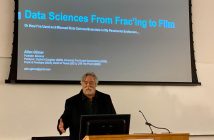
Troy Tassier, Ph.D., uses virtual cocktail parties as a way of measuring human behavior.
Photo by Bruce Gilbert
Picture a cocktail party full of artificial people, with predictable behavior. Imagine one detached observer on the sidelines, wondering who will be attracted to whom, and how long the party will last before everyone gets bored and goes home. A fairly typical scenario for a Saturday night in the city—except that this cocktail party is on a computer screen, and the observer is an economist sitting in his office.
This interactive exercise was undertaken by Troy Tassier, Ph.D., assistant professor of economics, as part of a summer workshop where, he recalls, “we spent our evening modeling a cocktail party instead of going [to one].” Although the exercise was more for amusement than scholarship, Tassier said that such research methodology can be applied to very significant scenarios—even life-and-death matters.
Tassier’s area of research is computational agent-based models, essentially computer programs of artificial people (known as “agents”) with well-established behavioral patterns. (Agent-based modeling is not unlike playing the computer game SimCity—a game that Tassier said he hasn’t tried.) Using such agent-based models, Tassier has researched trends in referral hiring and in fads, fashions and group formation. His current research looks at the spread of influenza across social networks, with an eye toward discovering an optimal vaccination strategy for workers in the health care industry.
“Some people think of economics as being boring, about money and business, but it is also a social science. It, too, studies the behavior of people,” Tassier said. “My academic research very much straddles sociology and economics, even though my formal training is as an economist. In fact, if you look at people who do research similar to mine, it is about a 50/50 split between the two fields.”
Tassier, who teaches at Fordham College Rose Hill, in the Graduate School of Arts and Sciences and in the International Political Economy and Development program, got interested in economics as an undergraduate, and following graduation took a job in the private banking sector. His job as a senior trader for a bank led to a position in mortgage lending, but he said that neither position was really very exciting. After two years he went to the University of Iowa to earn his master’s degree and doctorate in economics, largely for practical reasons—he had already earned an undergraduate degree in the field.
“I’m not a hugely social person, and am definitely introverted. But I have always been fascinated by the reasons why people have different behaviors,” he said.
Economics turned out to be a good fit for Tassier’s interest in people’s behavior. At the University of Michigan, he chose the field of complex systems for post-doctoral work. The value of study through complex systems, Tassier said, is to share the results of behavioral studies across the natural and social sciences. Tassier’s postdoctoral work looked at the benefits and detriments of diversity in a population.
“One of the principal things about agent-based economics and complex systems is the idea that economics should be done from a base level, working its way up to a market,” Tassier said. “You can’t really understand a market unless you understand the individual’s behavior in that market. If you start your modeling at too high a level, you are not going to have a good model. That’s why you do computational models with little people running around.”
Tassier’s research on referral hiring built upon a groundbreaking 1973 study done by Mark Granovetter, Ph.D., the John Butler Ford Professor of Sociology at Stanford University, on how people get hired at their jobs. Granovetter found that a person’s relationship to their family and friends (“strong ties”) will be less valuable in finding the best jobs than his/her relationship to acquaintances (“weak ties”). Further studies determined that affluent people had more weak ties than poor people had.
Tassier and Filippo Menczer, Ph.D., of the School of Informatics, Indiana University, took the ties study and applied it to groups rather than individuals. Their study, “Social Network Structure, Segregation, and Equality in a Labor Market with Referral Hiring,” suggests that strong ties can lead to better jobs in markets where job-specific (high skill) information is required. They cite an exclusive club as an example of a strong tie.
“If you think about country clubs, they are a great way to protect job information,” he said. “They are not set up explicitly for that, but, effectively, that is what happens. Information is kept inside that group. Organizations like women’s professional societies and minority-owned businesses are very valuable things because they allow these groups, once they get a foothold, to capitalize on that. The result [of the study]is potentially important for labor market minorities.”
His latest research also uses the strong ties–weak ties social network modeling technique to look at how influenza is spread among a hospital staff. (It is being funded by the University of Iowa Hospitals and Clinics and Tassier is working with Philllip Polgreen, M.D. of the University of Iowa.) Approximately 36,000 people die in the United States each year from influenza and currently there is no legislation requiring members of the health care field to be vaccinated.
“Social networks and epidemiology is a hot topic right now. The idea [is]that you don’t necessarily vaccinate people so that they don’t get sick, you vaccinate people so that they don’t get other people sick,” Tassier said. “If you think about elderly people, who currently receive most [of the vaccine], they don’t come in contact with as many people and are not as likely to spread it. In some cases, if we can concentrate on vaccinating the people passing on the disease instead of those getting sick, the incidences in the population can be cut for both the elderly and the population at large.”
– Janet Sassi

